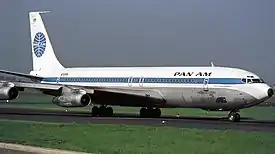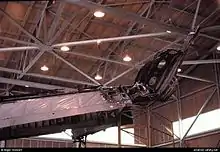Pan Am Flight 843
Pan Am Flight 843 was a scheduled domestic commercial flight from San Francisco, California to Honolulu, Hawaii. On June 28, 1965, Clipper Friendship,[2] the Boeing 707-321B operating this route, experienced an uncontained engine failure shortly after take-off, but was successfully able to make an emergency landing at the nearby Travis Air Force Base.[3] This accident was filmed by a passenger.
 N761PA, the aircraft involved, photographed in July 1973 | |
| Accident | |
|---|---|
| Date | June 28, 1965 |
| Summary | Uncontained engine failure and fire, causing in-flight structural failure |
| Site | On climb-out from takeoff at San Francisco International Airport 37°37′5.57″N 122°22′20.33″W |
| Aircraft | |
| Aircraft type | Boeing 707-321B |
| Aircraft name | Clipper Friendship[1] |
| Operator | Pan American World Airways |
| Registration | N761PA |
| Flight origin | San Francisco International Airport, San Francisco, California |
| Destination | Honolulu International Airport, Honolulu, Hawaii |
| Occupants | 153 |
| Passengers | 143 |
| Crew | 10 |
| Fatalities | 0 |
| Injuries | 0 |
| Survivors | 153 |
Accident
Flight 843, carrying 143 passengers and 10 crew members, took off around 2:00 pm PST on Monday, June 28, 1965. After going through the pre-flight check-list, Captain Charles Kimes, 44, let his co-pilot, Fred Miller, 48, handle the take-off. As the aircraft climbed to an altitude of approximately 800 feet, the number 4 (outer-right) engine exploded, rupturing the right outboard fuel tank and igniting the fuel inside. The explosion and resulting fire caused the last 25 or so feet of the right wing, along with the damaged engine, to break off from the rest of the aircraft.[3] Captain Kimes radioed the tower "I don't know whether I can keep it in the air or not."[4]
The pilots were able to extinguish the fire, after which they headed for Travis Air Force Base for an emergency landing. During this time, passenger William Richmond and his wife recorded footage of the burning wing with their camera. Finally, about 34 minutes after taking off, and with the landing gear lowered by emergency means,[5] Flight 843 landed safely at Travis. In the end, all 153 people on board survived unharmed. The success of the landing under the circumstances was described as a "miracle" by the news press.
Investigation
Three days before the accident on June 25, the number 4 engine was overhauled and seemed to work perfectly for 39 flight hours. The cause of the explosion was revealed to be a catastrophic failure of the engine's third stage turbine disk, resulting from a loss of operating clearance between the disk and the third stage inner sealing ring. Improper positioning of the turbine rotor, use of the wrong type of tool and worn parts included in the engine assembly process were blamed for that loss of clearance.[3] The CAB accident report states that the inspector on duty during the reinstallation of the turbine rotor "signed off on work he had not inspected".[6]

Aftermath
The number 4 engine ripped through the roof of a cabinet shop in San Bruno. Slashing through a wooden beam, the jet engine then penetrated an 8-inch thick concrete wall, damaging equipment outside, and came to rest on a mound of dirt. A large section of wing came down on Grand Avenue in South San Francisco, starting a grass fire. A 6-foot section of the wing hit the ground in Holy Cross cemetery and a charred chunk of the engine exhaust struck the rear of a housing area, also in South San Francisco. No injuries were reported.
While the passengers waited, Pan Am dispatched another 707 to Travis AFB to collect them and continue across the Pacific. This plane's nose gear collapsed on the runway, leaving the passengers dumbstruck. A third aircraft was sent, landing safely. Of the original 143 passengers all but 8 boarded the flight to Hawaii.[7]
Aircraft history
N761PA, Boeing 707-321B, Clipper Friendship, C/n 18336, was delivered to Pan Am on 13 June 1962. The aircraft was rebuilt and returned to service after this accident. It was withdrawn from use in December 1976, and placed in storage at Miami, Florida. Pan Am sold this Boeing 707 on 10 March 1977, to Dolphin Aviation, Inc., who in turn sold it to Air Manila, registered RP-C7075, on 1 May 1977. After several more operators, this Boeing 707 was bought on 7 May 1986, by the Boeing Military Airplane Company, and used as a source of spares for the Boeing KC-135E program. Reportedly, portions of the airframe are still extant at Davis Monthan Air Force Base, Arizona.[8]
See also
References
- Notes
- "Pan American Airways - Fleet List and Airframe Histories - The Boeing Jet Fleet (707 and 720)". logbookmag.com. Archived from the original on 2015-07-29. Retrieved 29 January 2015.
- "Pan Am Clipper Names 1934-1991". panamair.org/aircraft/clippernames.htm. Archived from the original on 11 March 2015. Retrieved 29 January 2015.
- "accident record". aviation-safety.net. Retrieved 29 January 2015.
- http://www2.readingeagle.com/article.aspx?id=384049. Reading Eagle. Published 2012-05-04
- Safety Last, page 42. ISBN 0-595-18693-9
- Safety Last, page 43. ISBN 0-595-18693-9
- https://www.youtube.com/watch?v=_-fNahas8Ro. KNBC television broadcast. 1965-06-28
- "Pan American Airways - Fleet List and Airframe Histories - The Boeing Jet Fleet (707 and 720)". Logbook Magazine. 2015-02-10. Archived from the original on 2015-07-29. Retrieved 2017-02-22.
- Sources
- Power-Waters, Brian (1972). Safety Last. Dial Press.
The repaired aircraft made an appearance in the 1966 film Dimension 5 @ 6.02
External links
- News clip with video.
- Life Magazine Article from 9 July 1965, Vol. 59, No. 2[1]
- "A Sight Few Have Seen and Lived to Tell About". article. Life Magazine. 9 July 1965. pp. 20–27. Retrieved 4 February 2021.